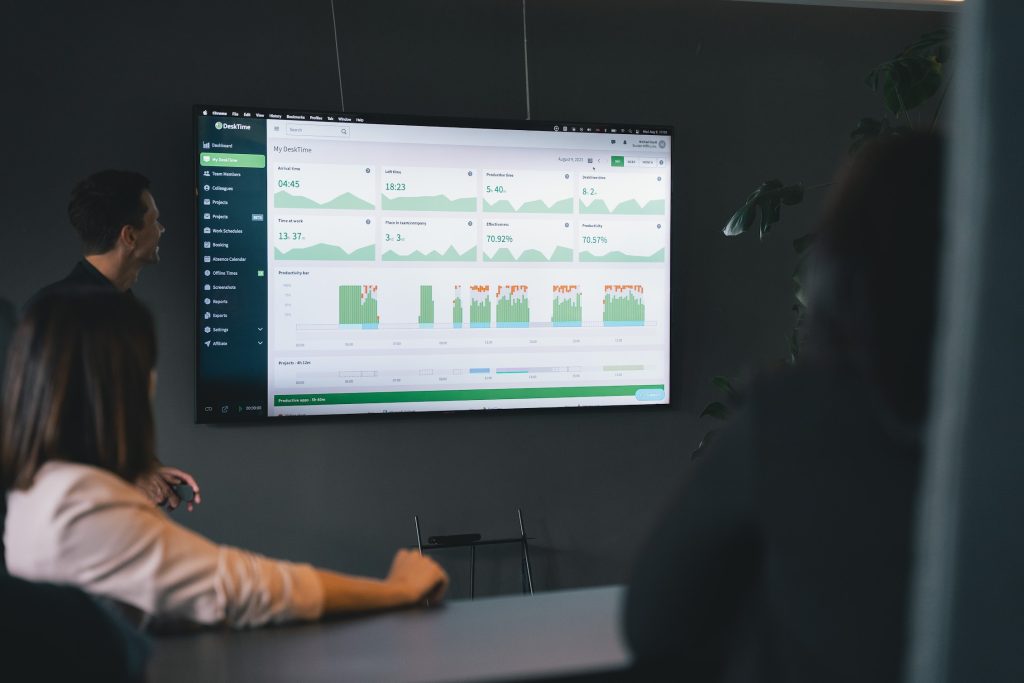The ultimate guide to employee time tracking apps
Employee time tracking has evolved significantly, with modern time tracker apps for employees offering advanced features to improve productivity and accountability. We’ve come a long way in tracking our work hours since 1888 when the first-ever employee time clock was built – now, we have a plethora of employee time tracking apps available with various features.
Employee time tracking is a well-known concept and a part of daily working life for many companies and teams. As remote work took over the scene in 2020, the use of employee time tracking apps surged notably, and it hasn’t really changed due to the beneficial nature of such software and tools.
However.
Not all companies have employee time tracking systems in place, and those who do could be using outdated tools. Being the employee time tracking experts that we are here at DeskTime, we have crafted this comprehensive guide. In it, we dive into things like what employee time tracking apps are (yes, the very basics!), the most common features, how tools differ, and, most importantly, how one begins to use time tracking in a company.
Without further ado – let’s dive into the exciting universe of employee time tracking apps!
Want to get the most out of your time?
Try DeskTime for free!
Try free for 14 days · No credit card required.
By signing up, you agree to our terms and privacy policy.

Table of contents
- What is an employee time tracking app?
- How do Employee Time Tracking Apps Work?
- The benefits of using a time tracking app for employees
- Types of employee time tracking tools
- What to look for in employee time tracking apps?
- How much does employee time tracking software cost?
- Best Employee Time Tracking Apps in 2025
- More Useful Employee Time Tracking Apps
- How To Choose an Employee Time Tracking App
- Criteria in Review
- Tips and tricks for implementing an employee hours tracker
- Give employee time tracking a try with DeskTime
- FAQ – Employee time tracking apps
- How to track time spent on tasks at work?
- How can I track my employees' time? And why is employee time tracking important?
- Is there an app to track employee work hours?
- What is the best time tracker for employees?
- Is an employee time tracking app a good fit for both small and large businesses?
- Is an employee time tracking app good for hybrid work?
What is an employee time tracking app?
Starting with the basics – an employee time tracking app is a digital tool built to ease and enhance the process of monitoring employee work hours, tasks, and productivity. It’s typically accessible via desktop or mobile devices and provides employers and managers with real-time insight into their workers’ activities.
Historically, the core function of employee time tracking apps was simple – they’d record when employees begin to work and when their workday ends. Today, most such tools have plenty of features, as basic clock-in and clock-out functionality alone doesn’t really sell. Plus, managers tend to care more about the work actually done rather than just the hours spent at work, which is why functionalities such as productivity tracking, project tracking, document title, URL and app tracking, and others are common in employee time tracking apps.
How do Employee Time Tracking Apps Work?
A time tracker for employees helps businesses monitor work hours efficiently, providing valuable data on productivity and attendance. Employee time tracking software allows team members to clock in and out, track time spent on tasks, and log breaks. Many employee time tracking apps also offer features like GPS tracking for remote workers, project-based tracking, and automated reports. An employee hours tracker captures real-time data, which managers can use for payroll, compliance, and performance evaluations. With an intuitive interface, these tools streamline time management and improve workflow efficiency.
The benefits of using a time tracking app for employees
We know very well that some people perceive employee time tracking apps as spying tools. But, in most cases, such opinions are voiced by those who have never used an employee time tracker and aren’t aware of the many benefits such tools bring to both businesses and workers.
While the benefits are many, here are the five most significant pros of using a time tracking app for employees:
- Increased transparency – and this supports not only the employer’s perspective but employees as well. Employee time tracking apps help both parties stay on the same page about the time worked and tasks done, spot potential struggles, and more.
- Improved productivity – insights into one’s working habits that employee time tracking systems provide are proven to boost employee productivity significantly. Moreover, such tools are usually designed to encourage employees to focus and avoid multitasking.
- Easier to bill and invoice clients – even the nicest of clients sometimes pull a Karen and start discussing the number of billable hours or the sum of the invoice. With an employee time tracking app in place, those types of conversations instantly become easier to handle – you have data on hours worked, hence, no room for clients to rain on your parade.
- Work flexibility and peace of mind – in 2020, when the pandemic-induced remote work era began, many companies turned to time trackers for support in managing their employees’ work hours. Plenty of those companies saw how beneficial flexible hours can be and how the right time tracker enables flexibility and non-intrusive accountability at the same time.
- Better employee management – data on hours worked and productivity levels not only helps employees manage their time and work efficiently but also gives employers information on individual workloads.

Types of employee time tracking tools
Now that you know what employee time tracking tools actually do and what their benefits are, it’s time to look into the types of time trackers. Here are some of the most common types of employee time tracking software.
Manual employee time tracking
Manual time tracking is the oldest form of tracking work hours – it means that employees take manual notes on time spent working. To do so, they can use paper timesheets, digital timesheets, or specific time cards.
Manual time tracking can be as simple as manually clocking in and out or having an additional layer where an employee adds descriptions of tasks performed during a workday.
Moreover, plenty of employee time tracking tools offer a manual time tracking feature, which can be especially useful if only a part (or none at all) of the job is done in front of a computer. It usually allows to manually fill in the “gaps” that the automatic time tracker has not registered.
This type of time tracking is usually low-cost and simple. However, it’s more prone to errors and less effective than, for example, automatic time tracking. Plus, manually logged hours and tasks are commonly reviewed by managers, which creates additional work.
Automatic time tracking
As you can probably deduce from the title, automatic time tracking is a method of recording work time using software or tools that don’t require manual input from employees. This form of employee time tracking is convenient and precise and makes the best use of time tracking software capabilities.
Automatic tracking can track various types of employee activity, such as app and URL use, keystrokes, mouse movements, and more. It can also detect if an employee is idle or away from a working device. It’s common that automatic time tracking tools enable employees to register idle time manually afterward – not being active on a computer doesn’t mean your employee wasn’t working, right?
Besides being convenient, automatic time tracking provides precise real-time information and makes time tracking effortless. Plus, if a specific tool generates reports on the tracked hours, managers can detect overtime workers and potential burnout employees, or notice if the workload isn’t distributed equally.
What’s also crucial is that automated tracking can offer higher security and privacy to employees – ensure that data is only available to authorized users, protect sensitive information, and more.

Project-based time tracking
Another sub-format of tracking employee work is project-based time tracking, which (surprise, surprise) is used by companies and teams working on projects. It allows you to know exactly how much time you’ve spent on a certain project, track billable hours, and calculate project costs as precisely as possible.
Why should you choose this type of tracking over manual or automated tracking? There are several reasons:
- It helps you track time spent on specific tasks or activities within a project, giving a detailed overview of each component’s time expenditure.
- People’s hourly rates can differ, and tracking each individual’s time spent on a project can make calculating the billable time and billing a client afterward much, much easier.
- Project-based time tracking provides more transparency when invoicing a project client, which is especially useful when dealing with clients’ objections.
- Tracking time spent on a specific project provides you with useful insights and can help with project planning, cost control, and resource allocation.
Time trackers for freelancers
You may think that when you’re your own boss, time tracking becomes irrelevant. Experienced freelancers will disagree, saying that there are plenty of reasons why freelancers need time tracking, and that’s exactly why it’s a thing.
This type of work tracking is similar to project-based tracking, as it records time spent on certain tasks for certain clients. Those juggling several clients can definitely benefit from an efficient freelance time tracking system due to several reasons, including precise billing, increased transparency, and accountability.
Additionally, it might be tricky to draw a line between work and life or to motivate yourself. Hence, freelance time tracking can come in handy.

What to look for in employee time tracking apps?
Whether we’ve already sold you the idea of implementing employee time tracking apps or not, let’s continue with the most crucial elements to look for when choosing a time tracker for employees.
Without the slightest doubt – there are p l e n t y of tools that can track one’s work hours, and there are quite a few features that such tools offer. However, when it comes to selecting a good employee time tracking app, there are some essential features that you should consider and look for:
- Type of time tracking – does the tool offer automatic, manual, project-based tracking, or maybe all of them? Can you track work hours if you work offline? Does the software have a mobile version? Think about your needs first and then compare them to the types of time entry a tool offers.
- Ease of use – you wouldn’t want a tool that takes a long time to understand and requires time-consuming management. Hence, read reviews, try demo versions, and go for a trial period.
- Integrations – whether you’re a manager of a large corporation or a freelancer, you likely use some tools and software, and having a time tracker that integrates with the tools already in place is important. It’s especially useful to integrate the tracker with project management tools, payroll systems, billing software, and more. Plus, compatibility with the hardware used is no less important to consider.
- Tracking projects and tasks – to bill your clients accurately, gathering precise data on time spent on certain projects is essential. Data on how much time your employees spend on certain tasks can also come in handy, especially when something seems off with their performance.
- Productivity tracking and measurement – productivity tracking and performance evaluation features are also something that you will be happy to have within a time tracking software for workers. This allows you to spot the best performers, boost employee productivity, and add more focus to your and your team’s workday.
- Reports & analytics – managing a business or a large team of employees requires a lot of decision-making, and with data at your fingertips, it becomes incomparably easier. Thus, reports and analytics are yet another feature to look for in a time tracking tool for employees. It can be more or less detailed – that’s up to your needs. But trust us, there will be a day you’ll be happy to have the chance to export an overview of your employee hours and productivity levels.
- Compliance and security – yes, tracking employee time means the software is dealing with potentially sensitive data, which is why the tool must be compliant with labor laws and data protection regulations that are relevant to your location. Employee privacy and security should be of the utmost importance to every manager – look for a tool with exceptional safety measures.
- Some extras you might need – there are plenty of custom features that your business could benefit from. For instance – shift scheduling, absence calendar, screenshots, integrations with specific tools, and more.
Features and functionality are crucial when it comes to choosing the right employee time tracking software for your business. But there are other factors that you shouldn’t overlook as well, such as:
- Cost-efficiency – does the tool offer everything you need, can you afford it, and does it offer several pricing options that can be adjusted if your needs change?
- Support – does the software company you’re about to pick offer support for its customers, and does its format suit you?
- User reviews – what other users say about the tool, and, more importantly, does the tool even have other users?
- Scalability – if your company (team, business, etc.) grows, will the tool be able to still serve your needs?

How much does employee time tracking software cost?
The cost of employee time tracking software varies based on the features and the number of users. Typically, a basic time tracker for employees starts around $5 to $10 per user per month. More advanced employee time tracking apps, which offer features like project tracking, GPS, and automated reporting, can range from $10 to $25 per user monthly. Some employee hours trackers offer free plans for small teams, but larger businesses often need premium options for comprehensive features. Prices for employee time tracking apps are often flexible, scaling with business size and requirements.
Best Employee Time Tracking Apps in 2025
| Software | Key Features | Pricing | Best For | Raiting |
| DeskTime | Automatic time tracking, project management, productivity monitoring, app/URL tracking, absence management, screenshots | Starts at $7/user/month | SMBs, remote teams | 4.6 |
| Harvest | Time and expense tracking, invoicing, project management, detailed reporting, integrations with Asana, Slack, and QuickBooks | Starting from $10/user per month | Freelancers, project managers | 4.6 |
| Time Doctor | Time tracking, employee monitoring, screenshots, payroll management, web/app usage tracking, distraction alerts | Starts at $7/user/month | Large teams, detailed monitoring | 4.5 |
| Hubstaff | GPS tracking, productivity monitoring, automated payroll, invoicing, and reporting features | Starts at $7/user/month | Field teams, remote teams | 4.5 |
| Insightful | Employee monitoring, productivity analytics, app/website tracking, project tracking, and reports | Custom pricing based on team size | SMBs, hybrid teams | 4.7 |
| Toggl Tracking | Simple time tracking, project and task tracking, reporting, integrations with project management tools, idle detection | Free plan available, Premium $10/user/month | Freelancers, small teams | 4.7 |
| QuickBooks Time | Time tracking, scheduling, GPS tracking, and seamless QuickBooks integration for payroll management | From $25/ user per month | QuickBooks users, small businesses | 4.7 |
DeskTime
DeskTime is an automatic time tracking app designed to boost productivity by providing detailed information about employee productivity. It also provides project tracking, which helps businesses monitor time spent on various tasks and generate detailed reports. With additional features like screenshots and URL tracking, DeskTime is ideal for small to medium businesses and remote teams looking for accountability. The software integrates with popular tools like Asana, Trello, and Jira, enhancing project management and team collaboration.
Harvest
Harvest is a versatile time tracking app focused on both time and expense tracking, making it perfect for freelancers and project managers. It offers invoicing features, allowing users to easily bill clients based on the tracked hours. Its intuitive reporting system helps teams gain insights into project progress and budgeting. Harvest integrates seamlessly with tools like Asana, Slack, and QuickBooks, making it a great choice for businesses that need flexible project management and invoicing in one platform.
Time Doctor
Time Doctor is a robust employee monitoring and time tracking tool that offers features like screenshots, web usage tracking, and distraction alerts. It is designed to ensure employees stay focused and productive, while managers can view detailed reports on time spent on tasks. The app also includes payroll management, making it ideal for larger teams or businesses that require detailed time tracking across multiple employees. Time Doctor’s distraction management features make it especially useful for remote teams.
Hubstaff
Hubstaff is a comprehensive time tracking solution featuring GPS tracking, project management, and productivity monitoring. It’s widely used by field teams and remote workers to track time, manage tasks, and streamline payroll. Hubstaff includes automated timesheets, screenshots, and invoicing tools, allowing businesses to manage both work time and client billing efficiently. With integration options for over 30 apps, including Asana and Trello, Hubstaff is perfect for remote and field-based businesses.
Insightful
Insightful is an employee monitoring and productivity analytics tool designed for businesses aiming to track work hours and optimize efficiency. It offers features like project tracking, app/website usage tracking, and advanced reporting. Insightful allows businesses to gain deep insights into employee behavior and productivity patterns, making it useful for both in-office and remote teams. It is highly customizable and works best for businesses looking to improve team productivity through real-time analytics.
Toggl Track
Toggl Track is a user-friendly time tracking app that is ideal for freelancers and small teams. It offers simple, one-click time tracking along with reporting features that provide detailed insights into work hours and project progress. Toggl integrates with several project management tools and is popular for its intuitive design and flexibility. It also includes features like idle detection and task labeling, which make it easy to monitor time spent on specific projects or tasks.
QuickBooks Time
QuickBooks Time (formerly TSheets) is a time tracking app integrated with QuickBooks, designed to simplify employee scheduling, time tracking, and payroll management. It includes GPS tracking, making it particularly useful for businesses with mobile or field teams. QuickBooks Time allows businesses to accurately track hours worked and streamline payroll by syncing directly with QuickBooks for seamless payroll processing. It’s an excellent choice for businesses that already use QuickBooks for accounting and payroll.
More Useful Employee Time Tracking Apps
In addition to popular options like DeskTime, Time Doctor, and Harvest, there are many other employee time tracking apps on the market that provide valuable solutions for businesses. Clockify is a popular free time tracker for employees, offering time tracking and reporting features for teams of all sizes. Timely uses automatic time tracking with AI to record work hours, making it a unique option. For teams looking for an employee hours tracker that integrates easily with payroll systems, Zoho Projects offers robust employee time tracking software combined with project management tools. These apps provide flexibility and productivity tools, making them essential in managing employee performance efficiently.
How To Choose an Employee Time Tracking App
Selecting the right employee time tracking app depends on several key considerations to ensure it aligns with your team’s unique needs. Start by evaluating your team size—certain apps cater to smaller teams with simpler features, while others provide advanced tools designed for larger, more complex organizations. Next, factor in your budget, aiming to balance affordability with essential functionality. Determine your must-have features, like automatic time tracking, integrations, or GPS for off-site employees. Finally, consider nice-to-have features that can enhance efficiency, such as advanced reporting or invoicing capabilities, but aren’t strictly necessary. Making the right choice will improve productivity and streamline daily operations.
Criteria in Review
Choosing the best employee time tracking app requires careful consideration of several factors:
- Team Size: The size of your workforce will determine which app suits your needs. Smaller teams may benefit from basic or free plans, while larger organizations will likely require more advanced features and scalability.
- Budget Considerations: It’s essential to weigh the cost of the software against its capabilities. Some apps offer free versions with limited functionality, but premium plans typically unlock enhanced features like advanced reporting and integrations.
- Essential Features: Focus on features that are non-negotiable for your business. For example, real-time tracking, mobile accessibility, and automated timesheets may be critical to managing productivity and payroll.
- Additional Features: While not essential, extra functionalities like in-depth analytics, invoicing, or seamless integration with existing tools (like project management or payroll software) can offer added convenience and value to your workflow.
Tips and tricks for implementing an employee hours tracker
Adding a new tool into a company’s workflow is always a bit tricky, employee hours trackers included. While most such software is not difficult to comprehend, it’s still a new tool to get used to.
Additionally, if your company hasn’t previously used an employee time tracking app, there is another layer of challenges ahead – explaining why your company needs time tracking in the first place, managing employee concerns regarding their privacy, and more.
Thus, in this section, we’ll be looking at things to bear in mind when implementing employee time tracking and a few handy tricks for using time tracking for employees.
Jot this down – best implementation practices
One way to implement employee time tracking in your company is to simply make everyone use a tool you’ve picked – no questions asked, no answers provided. But that’s certainly not the way to go if you wish to maintain a healthy work environment and avoid your employees hating you.
Luckily, a smooth implementation of an employee time tracking app can be achieved by following a few simple practices:
- Plan and prepare. Understand exactly why your organization needs time tracking and what the expected outcomes of its use are. Test the tool first (think of engaging a smaller group of employees in this) to see if it really lives up to your expectations. By the way, reading this article is already an important step toward successful implementation.
- Don’t be lousy on explanation. To receive the lowest possible resistance from your employees, you need to be deliberate in explaining everything about time tracking and how that will look at your company. Create material, do a presentation, organize workshops – whatever works best for your employees.
- Provide access to support. Even the most intuitive tools can be difficult to use for some people. Our brains are different (and that’s super cool), so remember to provide assistance with tool usage at the beginning and access to support all through your time tracking journey.
- Accept feedback – no matter what it is. Feedback given by your employees is the most valuable asset during time tracking implementation. It will help you determine whether the tool suits your company as you’ve imagined it or not. Planning is one thing, but real life always brings some surprises.
- Customize the tool if possible. By this, we mean things such as setting flexible work hours if you’re a flexible company, integrating the tool with other work apps, setting notifications so that they don’t interfere with your team’s workflow, and more.

Tips and tricks on using employee time trackers
Now, as promised, let’s check out some tips and tricks for using employee time trackers.
The good news is that most time tracking software is built to be user-friendly. Hence, there are not THAT many tips and tricks for using employee time tracking apps out there, but here are some worth checking out.
- Automate if you can. And that goes beyond choosing automated employee time tracking apps. The tools usually have options to add automated practices, such as idle detection or integration with project management software, so you don’t waste time on using the time tracking app.
- Integrations are there for a reason. Time tracking app integrations with third-party apps are there because they make everything more convenient and not just because somebody wanted them to be there. Some of the must-use integrations include calendars – Google and Outlook, as well as task management tools – Trello, Asana, Jira, Gitlab, and more.
- Encourage real-time tracking. Let’s say you’ve chosen a tool that offers both a manual time entry option and real-time tracking and some employees are hesitant to use the latter. The tip here is to explain the many benefits of real-time tracking versus manual entries, starting with the most upfront one – not needing to recall what you did during your 8-hour workday.
- Make use of the data. As your company uses time tracking, you gain unique access to various data that can be analyzed to optimize work. Spot company-wide tendencies, and adjust accordingly.
- Explore all of the features. Even if you know that all your company needs right now is basic time tracking, we advise you to check out all of the features the tool offers. Maybe there’s something you can adopt to make everyone’s life easier.
Give employee time tracking a try with DeskTime
DeskTime is an automated time tracking software perfect for companies and teams looking to boost their productivity and work efficiency. The tool tracks one’s work hours automatically, resulting in precise data with no manual entry (nor hassle) required. However, it also offers a manual time tracking opportunity, so that you can add information on time spent working away from your computer and make sure that every minute counts.
When it comes to features, DeskTime has plenty:
- Project tracking for project-based work
- URL and app tracking that helps with productivity measurement and provides a detailed overview of where your employees’ time is spent
- Productivity calculation to help you spot your top performers and notice those struggling
- Detailed reports – because data is power
- Integrations with the most-used calendar and project management apps
- And some extra features, such as Shift scheduling, Screenshots, and Absence calendar
Give DeskTime a go with our free trial, or start by exploring our demo account.
FAQ – Employee time tracking apps
How to track time spent on tasks at work?
To track time spent on tasks at work, you can use anemployee time tracking app or employee hours tracker that allows you to log hours for specific tasks. With employee time tracking software, employees can clock in and out of tasks, helping you analyze how much time is dedicated to each project or activity. Features like real-time tracking and project-based monitoring make it easier to ensure tasks are completed within set timeframes, boosting productivity and resource allocation.
How can I track my employees’ time? And why is employee time tracking important?
To keep track of employees’ time, using a time tracker for employees is essential. Employee time tracking software records work hours, including breaks and overtime, and logs time spent on specific tasks or projects. This helps ensure accuracy in payroll, compliance with labor regulations, and provides insight into employee productivity. Employee time tracking is crucial because it helps businesses optimize workflow, reduce inefficiencies, and ensure that employees are working the required hours, improving both accountability and productivity.
Is there an app to track employee work hours?
Yes, there are several apps available to track employee work hours. A time tracker for employees like DeskTime or Time Doctor can accurately record work hours, including start and end times, breaks, and even offline time. These employee hours trackers are especially useful for remote teams or businesses with flexible working hours, as they provide real-time data on employee attendance and productivity.
What is the best time tracker for employees?
That depends on needs of both your business and your employees, so it’s important to look for features that benefit both sides. Those include automatic tracking of time, detailed and transparent productivity reports and privacy features that protect employees from excessive monitoring.
Is an employee time tracking app a good fit for both small and large businesses?
Yes, an employee time tracking app is suitable for both small and large businesses. For small businesses, it helps manage time efficiently and improve accountability, while large organizations benefit from features like project tracking, automated reporting, and team management. Whether you need basic functionality or advanced features, a time tracker for employees can be tailored to fit the needs of companies of any size.
Is an employee time tracking app good for hybrid work?
Absolutely, an employee time tracking app is highly beneficial for hybrid work environments. These apps allow you to monitor both in-office and remote employees, ensuring accurate time tracking regardless of location. With features like GPS tracking and automated timesheets, employee time tracking software provides real-time data, making it ideal for managing teams that split their time between home and office settings. This helps maintain productivity and accountability across different work setups.
Did you find this article useful? Give it a clap!
Psst! You can clap more than once if you really loved it 🙂